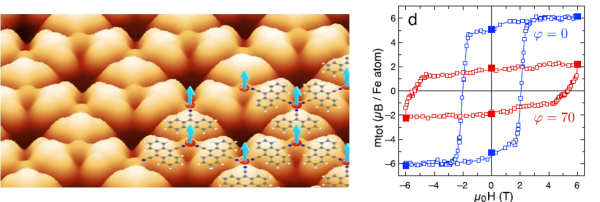Ferromagnetism on an atom-thick & extended 2D metal-organic coordination network
The appearance of ferromagnetic order at finite temperatures in extended two-dimensional (2D) systems requires the existence of magnetic anisotropy, so that a gap emerges in the magnon (spin wave) excitation spectrum. The magnitude of this gap plays a role in the determination of the value of the critical Curie temperature (TC) that also depends on other system parameters.
Recently, 2D single layers of different van der Waals materials have been isolated. For example, the case of a CrI3 monolayer is, nowadays considered a benchmark system for 2D ferromagnetism, presenting a value of TC close to 40 K, as well as an acoustic magnon mode [1]. A counterpart of such magnetic two-dimensional systems are the so-called metal-organic coordination networks (MOCNs), which consist of magnetic atoms linked by organic molecules. However, these systems have eluded, so far, the observation of ferromagnetism at finite temperatures. The main reason for such absence is that in most of the MOCNs exchange coupling strength and magnetic anisotropy are too low to deliver a large enough value of TC.

Figure. On the left, a high-resolution scanning tunneling image of the Fe-DCA MOCN is shown with Fe atoms (red circles) and DCA molecules overlayed on top. The blue arrows indicate the spin direction of the coordination magnetic atoms in this system. On the right, the hysteresis loops (open symbols) obtained at the L3 edge of Fe at normal (φ = 0°, blue) and grazing (φ = 70°, red) incidence are shown. The solid symbols are the result of applying the sum rules to the XAS and XMCD spectra obtained at remanence after conveniently cycling the field from ±6 T to zero for both incidence angles.
In this work, the authors have clearly observed ferromagnetism in a 2D MOCN. In particular, they have successfully grown a two-dimensional coordination network made of Fe atoms and DCA organic molecules (see Figure). They also have explained its remarkable magnetic properties. The resulting MOCN shows ferromagnetic order at relatively high critical temperatures (TC =35 K), as well as a large coercive field (Hc = 2 Tesla), a value comparable to the one corresponding to a neodymium magnet. Such high value of Hc could be considered a hard magnet, since it can maintain a given magnetization direction under the influence of a strong external magnetic field applied in the opposite direction, as defined by a hysteresis loop in the magnetization curve. In the figure below, the measured magnetization curves, as obtained from X-ray magnetic circular dichroism data, clearly show both the large out-of-plane anisotropy and large coercive field.
These findings represent a substantial advance in basic science as they show that single layers at its ultimate thickness can be ferromagnetic. Such finding has potential practical applications in technological devices requiring extreme miniaturization and strong magnetic fields, e. g., in spintronics devices. Moreover, the production costs become very low as this MOCN is composed of organic atoms (C, N and H) and only 5% of elemental Fe, whose atoms are located at distances of the order of 1 nm when incorporated in the MOCN.
References
[1] Nat. Phys. 17, 20 (2021). https://doi.org/10.1038/s41567-020-0999-1



